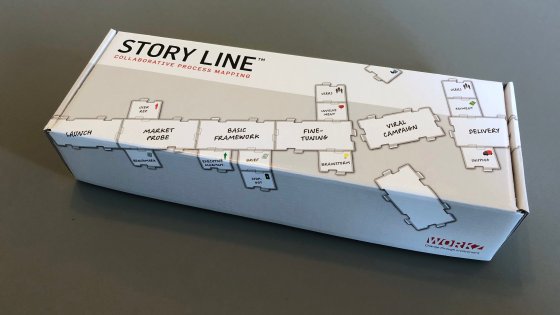-
 Store Line™ comes in a handy box with enough material for 3-6 people to map a fairly complex process.
Store Line™ comes in a handy box with enough material for 3-6 people to map a fairly complex process. -
 Each box has a guide.
Each box has a guide. -
 Guide contains a standard mapping process.
Guide contains a standard mapping process. -
 Symbols can be interpreted in many ways.
Symbols can be interpreted in many ways. -
 Pieces attachs any way you want.
Pieces attachs any way you want. -
 Writable surface.
Writable surface. -
 Mapping complex processes.
Mapping complex processes.
Story Line™ is an engaging and playful tool for mapping, changing and optimising plans, customer journeys and work-flows.
Story Line™ is a valuable part of our toolbox. We use the tool ourselves for everything from workflow optimisation through customer experience and service design to project planning and evaluation.
Make the complex simple
Many organisations work intensely with Lean and process optimisation, but without a good overview it is impossible to work with process development in a constructive way.
Mapping quickly becomes too complex for everyone but the person who made the spreadsheet or the flowchart. This goes for optimisation, waste reduction, streamlining of decision processes, service design as well as product development.
Story Line™ invites people to collaborate in a friendly and democratic way on creating shared proces visualisations.
Story Line™ is used to facilitate dialogues and create a shared understanding about any process. The tool sets the stage for user involvement and for the sharing of knowledge, experiences and inputs from different stakeholders in an innovative way.
Barriers and inappropriate ways of working become visible and tangible as the tool invites the participants to play with alternative process flows and different ways of utilising resources.
Telling the story
Story Line™ is made up of two different kinds of puzzle pieces. The large pieces, called Steps, are used to map the process while the small pieces, called Tags, have symbols on them and are used to represent details and stakeholders. The puzzle pieces help participants break the process down into smaller parts that can easily be attached, pulled apart and reattached to create an overview and inspire new insights.
The pieces make it easy and playfull top map any process wether you start with beginning or work yourself backwards from the end. Mapping the process is important, but the participants’ dialogue as they share perspectives are often more important.
References
Story Line™ has been used in a range of different contexts: from mapping patient journeys in the emergency care through helping Roland DG plan a remote storage facility in Russia and helping Novozymes identify ways to increase sustainable practices in their supply chain to being used as a coaching tool in ISS’ project management education.
"Workz used Story Line as part of a service design project about the merger of the Emergency Medical Service and the Emergency Room in our region. Senior doctors, doctors, nurses and patients helped each other map a series of complex patient trajectories. In this way they were made aware of how they viewed the existing processes and where they saw the potential for innovation" - Henrik Sprøgel, Head of the General Practitioners Section, Region Nordjylland
APPLICATIONS
- The tool can be used by everyone who wishes to work with process optimisation in an involving way.
- For analysis, evaluation and development and for project planning, service design and user involvement.
- The tool works ideally for creating overview, sharing experiences, idea generation and for having a dialogue about process flows.
- The tool is flexible and intuitive to use. A brief introduction is all that is needed to get everyone ready to start mapping.
FACTS
- Story Line™ can be used for short meetings or workshops, or as a tool you revisit as a part of a longer process.
- A box contains enough material to map a farily complex process. Leftover material can be used for the next workshop.
- Groups of 3-6 participants are ideal, and it is possible to let several groups work in parallel with different sets.
- The box comes with a guide and the different puzzle pieces arranged in compartments according to when they are used in a standard mapping process.

